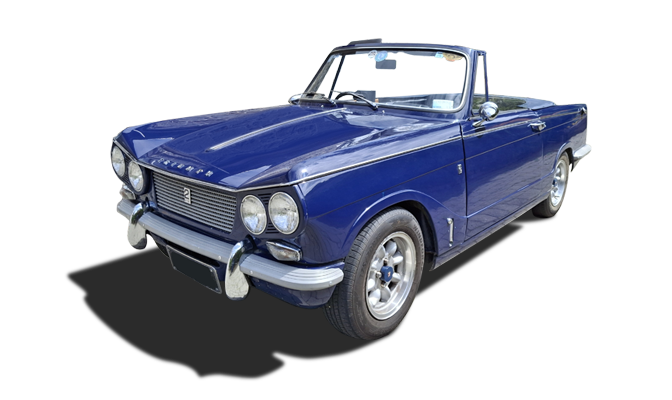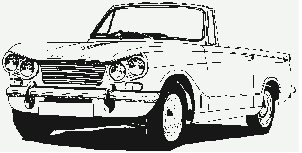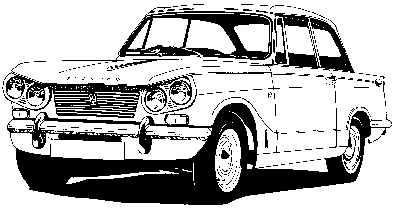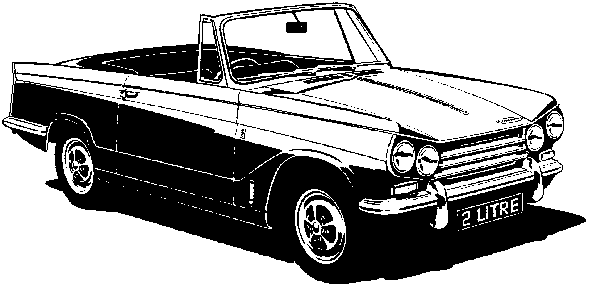
The Triumph Vitesse was a compact six cylinder car built by Standard-Triumph from 1962 to 1971. The car was styled by Michelotti, and was available in saloon and convertible variants.
The Vitesse name had previously been used by Triumph on a car made between 1936 and 1938, also by G.N.(Godfrey & Nash) on their 1922 GN Vitesse Cyclecar, and earlier yet by Austin on their 1914-16 Austin 20 (hp) and 30 (hp) Vitesse models.
After the last Triumph Vitesse was made in July 1971, the name remained unused until October 1982, when Rover used it on their SD1 until 1986, and one final time on their Rover 800, 820 & 827 models from October 1988 to 1991, at which time that car was rebodied as the ‘R17’ version which was produced until 1998 as the Rover Vitesse Sport.

The Triumph Vitesse was introduced on 25 May 1962, re-using a name previously used by the pre-World War II Triumph company from 1936–38, and was an in-line 6-cylinder performance version of the Triumph Herald small saloon. The Herald had been introduced on 22 April 1959 and was an attractive 2-door car styled by the Italian designer Giovanni Michelotti.
By the early 1960s, however, Triumph began to give thought to a sports saloon based on the Herald and using their 6-cylinder engine. Michelotti was again approached for styling, and he came up with a car that used almost all body panels from the Herald, combined with a new front end with a slanted “Chinese Eye” 4-headlamp design.
Standard-Triumph fitted a 1596 cc version of their traditional straight-6 derived from the engine used in the Standard Vanguard Six, but with a smaller bore diameter of 66.75 mm (2.628 in), compared with the 74.7 mm (2.94 in) bore on the Vanguard, equipped with twin Solex B32PIH semi-downdraught carburettor These were soon replaced by B321H carburettors, as the accelerator pumps proved a problem The curious observer will notice a “seam” on the cylinder block between the third & fourth cylinders revealing the humble design beginnings from the 803 cc Standard 8 block of 1953. The gearbox was strengthened and offered with optional Laycock De Normanville ‘D-type’ overdrive. Front disc brakes were standard as were larger rear brake drums, and the Herald fuel tank was enlarged, retaining the handy reserve tap of the smaller Herald tank. The front suspension featured uprated springs to cope with the extra weight of the new engine, but the rear suspension was basically standard Herald—a swing-axle transverse-leaf system which quickly proved inadequate for the relatively powerful Vitesse. The chassis was basically the same as the Herald, and the Vitesse was available in convertible and saloon forms; a coupé never got beyond the prototype stage. A handful of Vitesse estates also were assembled to special order at Standard-Triumph’s Service Depot at Park Royal in West London.
The interior was much improved over the Herald; wooden door cappings were added to match the wooden dashboard and the car featured better seats and door trims. Optional extras included a vinyl/fabric, (Webasto), sunroof on saloon models. Exterior trim was also improved with stainless steel side trim and satin-silver anodised alloy bumper cappings (replacing the white rubber Herald design). The prospective buyer of a classic Vitesse will do well to check that the side flashes are full-length and continue around the radiator grille.
A year or so after the car’s launch, the Vitesse received its first facelift; the dashboard was revised with a full range of instruments instead of the large single dial from the Herald, and from September 1965, at commission number HB27986, the twin Solex carburettors were replaced by twin Zenith- Stromberg CD 150carburettors. Power output increased from the original 70 bhp (52 kW) at 5,000 rpm & torque of 92.5 lb·ft (125 N·m), enough to provide a useful performance boost and making the car a much more flexible performer. There was a claimed, although somewhat optimistic increase of 13-14 bhp, and the motoring magazine tested top speed rose to 91 mph (146 km/h), with the 0–80 mph (0–130 km/h) time decreasing from 46.6 seconds to just 33.6 seconds.
The Vitesse 6 sold extremely well for Triumph, and was by some way the most popular Vitesse sold during the model’s lifetime. The car was well liked for its performance and reasonable fuel economy, as well as the well appointed interior. The Vitesse had few rivals for the price: able to perform as well as many sports cars, but with room for a family. The convertible in particular was virtually unique in the marketplace and another genuine 4-seater sporting convertible would not reappear from a British manufacturer until the Triumph Stag several years further down the line.
The Vitesse 6 convertible was exported to the United States as the left-hand drive Triumph Sports 6, from 1962–1964, and was marketed as a “limited edition car”, but due to its retail price only 679 were sold in the U.S. before it was withdrawn.
The Sports 6 was perhaps better suited to American highways than was the Herald, but it faced stiff price competition from cars such as Ford’s new Mustang. The Vitesse Saloon was not officially imported to the U.S., although a few do come up as P.E.D. (Personal Export Delivery), cars usually imported by American service personnel. Original U.S. price (POE East Coast) was $2499 for the Sports 6 Convertible which were usually delivered in White, Signal Red or Black.

In 1966 Triumph upgraded the engine to 1998 cc, in line with the new Triumph GT6 coupé, and relaunched the car as the Vitesse 2-Litre. Power was increased to 95 bhp (71 kW), endowing the new car with a 0–60 mph time of around 13 s. (The 2-Litre was advertised by Triumph as “The Two Seater Beater”)
The performance increase was welcome, but it highlighted the deficiencies of the rear suspension, also noted on the new GT6 and the Spitfire. There were detail modifications for the 2-litre, including a stronger gearbox and uprated brakes, and an oblong ‘VITESSE’ badge on the satin silver anodised aluminium-alloy cowling above the reversing light.

The Vitesse Mark 2 was launched in 1968 as the final update to the Vitesse range. Essentially intended to be Triumph’s answer to growing criticism of the rear suspension, the Mark 2 was fitted with a completely redesigned layout using Rotoflex rear couplings. This system, also shared with the new GT6 MKII, (GT6+ in the U.S. market), tamed the wayward handling for good and endowed the Vitesse with firm, progressive roadholding.
There were other improvements: the engine was tweaked once more to provide 104 bhp (78 kW), cutting the 0–60 time to just over 11 s and providing a top speed easily in excess of 100 mph (160 km/h). The exterior featured a new grille, Rostyle wheeltrims and silver painted steel rear panel, (described by Triumph as ‘ceramic’), and the interior was upgraded once more in order to share parts with the new Herald 13/60. A new colour range was offered for the Mark 2 models. The aluminium cowling above the reversing light remained, but no longer had a chromed ‘VITESSE’ badge on it. The separate chromed mezak TRIUMPH letters on the bonnet and the boot lid were also deleted.
This was the ultimate Vitesse, a saloon or convertible with performance easily superior to an MGB or Sunbeam Alpine sports car but with four proper seats and a large boot.[citation needed] The Vitesse sold well until its withdrawal in July 1971, a year before the new Triumph Dolomite saloon entered the performance luxury sector for Triumph, and two years before the Dolomite Sprint variant added another high-performance sports saloon to the range. Although the Vitesse was an older model, it proved to be more reliable than its replacement.
The Vitesse competed in the Monte Carlo Rally in the early ’60s and the Trans-Am in 1971.
Today, the Triumph Vitesse is much sought-after car by enthusiasts; parts supply is excellent, and the cars have a reputation for near ‘bullet-proof’ mechanics. The Vitesse 6—especially the early Solex-carburettored version—has been somewhat forgotten, and these cars are now becoming scarce. Most popular are the Mark 2 cars for their power and handling, and convertibles in particular continue to be in high demand. Survival rate of the Mark 2, especially the convertible, is surprisingly high and could help explain the relatively low number of older, especially Vitesse 6 saloons, remaining. These lower powered cars have tended to be broken for spares to keep the 2-Litres & Mark 2s on the road. Club support is excellent, and the Vitesse represents a practical and desirable performance 4-seater.
The Vitesse uses a separate chassis which makes the car very simple to work on. As this chassis provides the backbone of the car, it is important that it is in good condition and free from accident damage. Check the main chassis members where the suspension is attached for kinks, cracks and distortion which will be the result of crash damage. If you find this, the car is best avoided. Check the two side rails of the chassis for corrosion, especially where they meet the main rails and outriggers also check the main chassis rails around the differential and the two rear outrigger legs that the rear bodytub sits on – these are a well known rust-traps.
Check the two front outriggers that the bulkhead attaches to. If possible have a good poke around with a screwdriver, particularly where they are bolted on to the bulkhead. Chassis sections can be replaced but body corrosion here is difficult to repair properly. Have a look at the remainder of the chassis along the centre of the car as this is worth checking but hardly ever rusts badly.
A good initial guide to the overall condition of the car can be ascertained by the quality of the panel fit and alignment. The door caps should be even and the door should sit squarely between the `A’ and `B’ posts. Check bonnet fitment against the bulkhead. There is scope for adjustment on the bonnet so don’t worry too much. Incorrectly replaced front wings can pull the bonnet out of shape.
Other places to check are: front footwells, wheel arch lips, rear inner wings and boot floor. Panel availability is reasonably good, with many repair sections now available. Check all over for body filler, especially around the lips of the wheel arches.
The big advantage with checking the mechanical parts is that they are all easily accessible. Start the engine but don’t rev. it. Listen for initial crankshaft rumble which should only last for a few seconds until the oil pressure has built up. Also listen for tappet and timing chain rattle There should be no excessive oil leaks but check the head gasket, sump gasket and the rocker cover gasket for any signs of leaks.
Check the suspension by bouncing each corner and allowing it to spring up and back down once. More than one cycle indicates defective shock absorbers.
Check that the brakes are not binding and that the handbrake is working efficiently.
Check the steering column and rack for excessive movement by rocking the steering wheel up and down and check that there is no play between moving the steering wheel and the road wheels moving.
Make sure you are insured to drive the vehicle on the road!! Move off in first gear and listen for rear end knocks or clonks, which point to worn rear axle or propshaft universal joints.
Increase speed and move up and down the gears, ensuring that all gears select correctly with minimum effort. If an overdrive gearbox is fitted, check that it engages and dis-engages correctly in third and fourth gears. Cruise at around 50 mph and gently lift off on the accelerator, listening for rear end noises. A regular knocking is likely to be a universal joint; a rumble is usually a differential problem.
Still at 50 mph slip the clutch, build up the revs and re-engage the clutch; it should bite cleanly with no slip. Check for front wheel vibration and positivity of the steering. Vibration is usually caused by worn wheel bearings, a worn steering rack or incorrect wheel balance.
On a straight road, apply the footbrake with increasing pressure. The car should stop evenly without pulling to one side.
Check the temperature gauge for overheating problems.